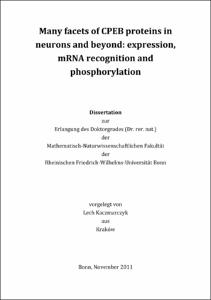Many facets of CPEB proteins in neurons and beyond: expression, mRNA recognition and phosphorylation

Many facets of CPEB proteins in neurons and beyond: expression, mRNA recognition and phosphorylation

| dc.contributor.advisor | Steinhäuser, Christian | |
| dc.contributor.author | Kaczmarczyk, Lech | |
| dc.date.accessioned | 2020-04-18T20:52:00Z | |
| dc.date.available | 2020-04-18T20:52:00Z | |
| dc.date.issued | 10.06.2013 | |
| dc.identifier.uri | https://hdl.handle.net/20.500.11811/5696 | |
| dc.description.abstract | CPEBs are a family of evolutionary conserved auxiliary translational factors. They bind to CPEs in the 3’UTR of target mRNA and, by interacting with other members of the translational machinery, promote or decrease gene expression. Since the first description of CPEB protein as a key orchestrator of oocyte maturation in Xenopus Laevis, key functions of CPEBs in embryonic development, cellular senescence and synaptic plasticity have been described. Local, postsynaptic modulation of synaptic efficacy is the most studied function of CPEBs in the CNS. However, the expression of CPEBs is not restricted to neurons and even 7% of total brain mRNAs possesses CPEs. Moreover, specific mRNAs are enriched in functionally distinct subcellular regions, like dendritic spines of neurons or complex cellular processes of astrocytes, where they might be translationally regulated. Herein, I embarked on further elucidating the role of CPEB translational regulators family in selected cell populations in mouse brain. In the first part of the work, the target mRNA specificity of different CPEBs was tested. I argued with the hypothesis that CPEBs -3 and -4 require mRNA secondary structure (a stem-loop) for target recognition. I showed that despite differences in the RBD primary structure, CPEB-1 shows a considerable sequence specificity overlap with CPEB-3 (and possibly, due to sequence similarity, with CPEBs -2 and -4 as well). This holds true for neuronal (CaMKIIα) and astrocytic(β-catenin) CPEB targets. Additionally, RNAco-immunoprecipitation revealed two novel CPEB target mRNAs, encoding (1) an astrocytic gap junction protein (Connexin43) and (2) CPEB-3 protein itself. In the first part of the work, the target mRNA specificity of different CPEBs was tested. I argued with the hypothesis that CPEBs -3 and -4 require mRNA secondary structure (a stem-loop) for target recognition. I showed that despite differences in the RBD primary structure, CPEB-1 shows a considerable sequence specificity overlap with CPEB-3 (and possibly, due to sequence similarity, with CPEBs -2 and -4 as well). This holds true for neuronal (CaMKIIα) and astrocytic(β-catenin) CPEB targets. Additionally, RNAco-immunoprecipitation revealed two novel CPEB target mRNAs, encoding (1) an astrocytic gap junction protein (Connexin43) and (2) CPEB-3 protein itself. In the second part of the thesis, CPEBs 1-4 gene expression in microglia, NG2 cells and astrocytes was assessed at the mRNA and protein level, confirming the ubiquitous nature of the CPEB expression. A more detailed analysis of CPEB-3 mRNA revealed expression of only certain isoforms of the protein in ESdM cells. Each CPEB family member occurs in several splice variants. Hitherto, only a handful of reports are dealing with the significance of alternative splicing of CPEBs. Interestingly, regulation of expression of CPEBs in neurons may happen in an isoform-specific fashion. Seeing this as a highly intriguing phenomenon, I focused on CPEB-3, containing a putative kinase recognition site on the alternatively spliced exon 5. In a cell-free systems and in cultured cells, I showed that CPEB-3 is a target of PKA and CaMKII – both critical for LTP/LTD, and that exon 5 harbors a consensus sequence required for kinase recognition. In vivo, in a transgenic mouse overexpressing CPEB3 protein in principal neurons of the hippocampus, I founda significant decrease in GluR2 AMPA-R subunit protein levels. In view of the above, the stimulation-induced phosphorylation of CPEB-3 may very well be a novel mechanism of translational modulation of synaptic plasticity. In the final part of the thesis, I aimed at establishing a quality control method for Cre-mediated gene deletions. Using Cx30-/-;Cx43fl/fl mice with hGFAP-Cre recombinase driver, I developed a reliable immunoblot-based tool for post-hoc control of recombination variability in hGFAP-Cre transgenic mice. | en |
| dc.language.iso | eng | |
| dc.rights | In Copyright | |
| dc.rights.uri | http://rightsstatements.org/vocab/InC/1.0/ | |
| dc.subject | CPEB | |
| dc.subject | Cx43 | |
| dc.subject | translation | |
| dc.subject | mRNA | |
| dc.subject.ddc | 570 Biowissenschaften, Biologie | |
| dc.title | Many facets of CPEB proteins in neurons and beyond: expression, mRNA recognition and phosphorylation | |
| dc.type | Dissertation oder Habilitation | |
| dc.publisher.name | Universitäts- und Landesbibliothek Bonn | |
| dc.publisher.location | Bonn | |
| dc.rights.accessRights | openAccess | |
| dc.identifier.urn | https://nbn-resolving.org/urn:nbn:de:hbz:5n-32369 | |
| ulbbn.pubtype | Erstveröffentlichung | |
| ulbbnediss.affiliation.name | Rheinische Friedrich-Wilhelms-Universität Bonn | |
| ulbbnediss.affiliation.location | Bonn | |
| ulbbnediss.thesis.level | Dissertation | |
| ulbbnediss.dissID | 3236 | |
| ulbbnediss.date.accepted | 08.06.2012 | |
| ulbbnediss.fakultaet | Mathematisch-Naturwissenschaftliche Fakultät | |
| dc.contributor.coReferee | Witke, Walter |
Files in this item
This item appears in the following Collection(s)
-
E-Dissertationen (4446)




